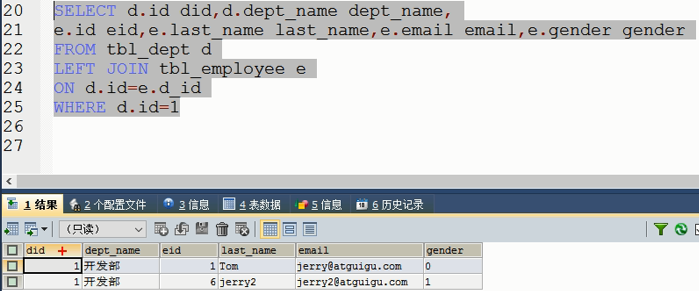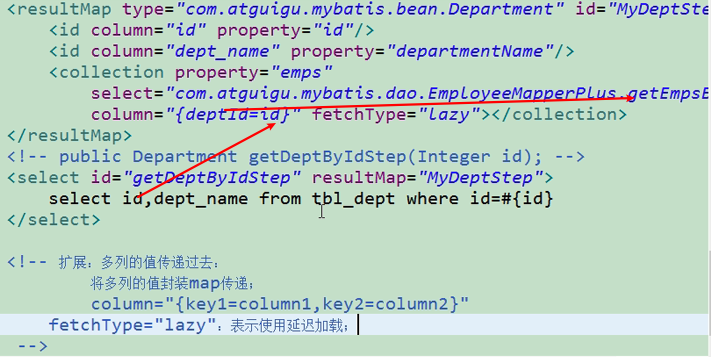1、select返回List



<!-- public List<Employee> getEmpsByLastNameLike(String lastName); -->
<!--resultType:如果返回的是一个集合,要写集合中元素的类型 -->
<select id="getEmpsByLastNameLike" resultType="com.atguigu.mybatis.bean.Employee">
select * from tbl_employee where last_name like #{lastName}
</select>
2、select返回Map



以上是单条记录封装,多条记录如下:


Map中的key怎么知道要用主键来做呢?





<!--public Map<Integer, Employee> getEmpByLastNameLikeReturnMap(String lastName); -->
<select id="getEmpByLastNameLikeReturnMap" resultType="com.atguigu.mybatis.bean.Employee">
select * from tbl_employee where last_name like #{lastName}
</select>
<!--public Map<String, Object> getEmpByIdReturnMap(Integer id); -->
<select id="getEmpByIdReturnMap" resultType="map">
select * from tbl_employee where id=#{id}
</select>
3、自定义结果映射规则resultMap


<mapper namespace="com.atguigu.mybatis.dao.EmployeeMapperPlus">
<!--自定义某个javaBean的封装规则
type:自定义规则的Java类型
id:唯一id方便引用
-->
<resultMap type="com.atguigu.mybatis.bean.Employee" id="MySimpleEmp">
<!--指定主键列的封装规则
id定义主键会底层有优化;
column:指定哪一列
property:指定对应的javaBean属性
-->
<id column="id" property="id"/>
<!-- 定义普通列封装规则 -->
<result column="last_name" property="lastName"/>
<!-- 其他不指定的列会自动封装:我们只要写resultMap就把全部的映射规则都写上。 -->
<result column="email" property="email"/>
<result column="gender" property="gender"/>
</resultMap>
<!-- resultMap:自定义结果集映射规则; -->
<!-- public Employee getEmpById(Integer id); -->
<select id="getEmpById" resultMap="MySimpleEmp">
select * from tbl_employee where id=#{id}
</select>
......
</mapper>
4、一对一(查询Employee的同时查询员工对应的部门)
方式一:级联属性
Employee
@Alias("emp")
public class Employee {
private Integer id;
private String lastName;
private String email;
private String gender;
private Department dept;
Department
public class Department {
private Integer id;
private String departmentName;
private List<Employee> emps;




<!--
场景一:
查询Employee的同时查询员工对应的部门
Employee===Department
一个员工有与之对应的部门信息;
id last_name gender d_id did dept_name (private Department dept;)
-->
<!--
联合查询:级联属性封装结果集
-->
<resultMap type="com.atguigu.mybatis.bean.Employee" id="MyDifEmp">
<id column="id" property="id"/>
<result column="last_name" property="lastName"/>
<result column="gender" property="gender"/>
<result column="did" property="dept.id"/>
<result column="dept_name" property="dept.departmentName"/>
</resultMap>
方式二association
<!--
使用association定义关联的单个对象的封装规则;
-->
<resultMap type="com.atguigu.mybatis.bean.Employee" id="MyDifEmp2">
<id column="id" property="id"/>
<result column="last_name" property="lastName"/>
<result column="gender" property="gender"/>
<!-- association可以指定联合的javaBean对象
property="dept":指定哪个属性是联合的对象
javaType:指定这个属性对象的类型[不能省略]
-->
<association property="dept" javaType="com.atguigu.mybatis.bean.Department">
<id column="did" property="id"/>
<result column="dept_name" property="departmentName"/>
</association>
</resultMap>
<!-- public Employee getEmpAndDept(Integer id);-->
<select id="getEmpAndDept" resultMap="MyDifEmp2">
SELECT e.id id,e.last_name last_name,e.gender gender,e.d_id d_id,
d.id did,d.dept_name dept_name FROM tbl_employee e,tbl_dept d
WHERE e.d_id=d.id AND e.id=#{id}
</select>
方式三:使用association进行分步查询


<!-- 使用association进行分步查询:
1、先按照员工id查询员工信息
2、根据查询员工信息中的d_id值去部门表查出部门信息
3、部门设置到员工中;
-->
<!-- id last_name email gender d_id -->
<resultMap type="com.atguigu.mybatis.bean.Employee" id="MyEmpByStep">
<id column="id" property="id"/>
<result column="last_name" property="lastName"/>
<result column="email" property="email"/>
<result column="gender" property="gender"/>
<!-- association定义关联对象的封装规则
select:表明当前属性是调用select指定的方法查出的结果
column:指定将哪一列的值传给这个方法
流程:使用select指定的方法(传入column指定的这列参数的值)查出对象,并封装给property指定的属性
-->
<association property="dept"
select="com.atguigu.mybatis.dao.DepartmentMapper.getDeptById"
column="d_id">
</association>
</resultMap>
<!-- public Employee getEmpByIdStep(Integer id);-->
<select id="getEmpByIdStep" resultMap="MyEmpByStep">
select * from tbl_employee where id=#{id}
<if test="_parameter!=null">
and 1=1
</if>
</select>
开启懒加载全局配置



<!-- 可以使用延迟加载(懒加载);(按需加载)
Employee==>Dept:
我们每次查询Employee对象的时候,都将一起查询出来。
部门信息在我们使用的时候再去查询;
分段查询的基础之上加上两个配置:
-->
5、一对多(查询对应部门的所有员工信息)

方式一:collection 嵌套
<!--
public class Department {
private Integer id;
private String departmentName;
private List<Employee> emps;
did dept_name || eid last_name email gender
-->
<!--嵌套结果集的方式,使用collection标签定义关联的集合类型的属性封装规则 -->
<resultMap type="com.atguigu.mybatis.bean.Department" id="MyDept">
<id column="did" property="id"/>
<result column="dept_name" property="departmentName"/>
<!--
collection定义关联集合类型的属性的封装规则
ofType:指定集合里面元素的类型
-->
<collection property="emps" ofType="com.atguigu.mybatis.bean.Employee">
<!-- 定义这个集合中元素的封装规则 -->
<id column="eid" property="id"/>
<result column="last_name" property="lastName"/>
<result column="email" property="email"/>
<result column="gender" property="gender"/>
</collection>
</resultMap>
<!-- public Department getDeptByIdPlus(Integer id); -->
<select id="getDeptByIdPlus" resultMap="MyDept">
SELECT d.id did,d.dept_name dept_name,
e.id eid,e.last_name last_name,e.email email,e.gender gender
FROM tbl_dept d
LEFT JOIN tbl_employee e
ON d.id=e.d_id
WHERE d.id=#{id}
</select>
方式二:collection分步查询

<!-- public List<Employee> getEmpsByDeptId(Integer deptId); -->
<select id="getEmpsByDeptId" resultType="com.atguigu.mybatis.bean.Employee">
select * from tbl_employee where d_id=#{deptId}
</select>
<!-- collection:分段查询 -->
<resultMap type="com.atguigu.mybatis.bean.Department" id="MyDeptStep">
<id column="id" property="id"/>
<id column="dept_name" property="departmentName"/>
<collection property="emps"
select="com.atguigu.mybatis.dao.EmployeeMapperPlus.getEmpsByDeptId"
column="{deptId=id}" fetchType="lazy"></collection>
</resultMap>
<!-- public Department getDeptByIdStep(Integer id); -->
<select id="getDeptByIdStep" resultMap="MyDeptStep">
select id,dept_name from tbl_dept where id=#{id}
</select>


分步查询多列值&fetchType

<!-- collection:分段查询 -->
<resultMap type="com.atguigu.mybatis.bean.Department" id="MyDeptStep">
<id column="id" property="id"/>
<id column="dept_name" property="departmentName"/>
<collection property="emps"
select="com.atguigu.mybatis.dao.EmployeeMapperPlus.getEmpsByDeptId"
column="{deptId=id}" fetchType="lazy"></collection>
</resultMap>
<!-- public Department getDeptByIdStep(Integer id); -->
<select id="getDeptByIdStep" resultMap="MyDeptStep">
select id,dept_name from tbl_dept where id=#{id}
</select>
<!-- 扩展:多列的值传递过去:
将多列的值封装map传递;
column="{key1=column1,key2=column2}"
fetchType="lazy":表示使用延迟加载;
- lazy:延迟
- eager:立即
-->
6、鉴别器

<!-- =======================鉴别器============================ -->
<!-- <discriminator javaType=""></discriminator>
鉴别器:mybatis可以使用discriminator判断某列的值,然后根据某列的值改变封装行为
封装Employee:
如果查出的是女生:就把部门信息查询出来,否则不查询;
如果是男生,把last_name这一列的值赋值给email;
-->
<resultMap type="com.atguigu.mybatis.bean.Employee" id="MyEmpDis">
<id column="id" property="id"/>
<result column="last_name" property="lastName"/>
<result column="email" property="email"/>
<result column="gender" property="gender"/>
<!--
column:指定判定的列名
javaType:列值对应的java类型 -->
<discriminator javaType="string" column="gender">
<!--女生 resultType:指定封装的结果类型;不能缺少。/resultMap-->
<case value="0" resultType="com.atguigu.mybatis.bean.Employee">
<association property="dept"
select="com.atguigu.mybatis.dao.DepartmentMapper.getDeptById"
column="d_id">
</association>
</case>
<!--男生 ;如果是男生,把last_name这一列的值赋值给email; -->
<case value="1" resultType="com.atguigu.mybatis.bean.Employee">
<id column="id" property="id"/>
<result column="last_name" property="lastName"/>
<result column="last_name" property="email"/>
<result column="gender" property="gender"/>
</case>
</discriminator>
</resultMap>